What is BCM in ceramic anilox roller?
In industrial production, ceramic anilox roller is a very critical equipment in the printing and coating industry. Its main function is to control the uniform distribution of coatings, inks or other liquids to ensure that the product maintains high quality during the production process. When discussing ceramic anilox rollers, the concept of BCM (Billion Cubic Microns per Square Inch) cannot be ignored. BCM is an important parameter for measuring the amount of liquid transferred by ceramic anilox rollers, which directly affects the coating thickness, ink uniformity and overall production results. Therefore, understanding BCM and its role in ceramic anilox rollers is of vital importance for coating and printing processes in the manufacturing industry.

What is BCM?
BCM (Billion Cubic Microns) is a unit of mesh volume per square inch on a ceramic anilox roller. Specifically, it represents the volume of mesh per square inch, and the unit is "billions of cubic microns per square inch". This value is usually used to describe how much liquid the mesh on the surface of the anilox roller can hold, that is, the mesh volume per unit area.
Unit analysis of BCM
1 BCM = 100 million cubic microns/square inch. This value can clearly indicate how much liquid each mesh can carry on the roller surface. The larger the BCM value, the larger the capacity of the mesh and the more liquid that can be transferred.
BCM is a key indicator that determines the coating or printing effect. It can help manufacturers accurately control the distribution of liquid and ensure the stability of the final product quality.
What is the role of BCM in ceramic anilox roller?
The core task of ceramic anilox roller is to transfer liquid (such as ink, coating, adhesive, etc.) evenly to the surface of the material through the mesh engraved on its surface. As a standard for measuring the mesh volume, BCM determines the amount of liquid transferred each time, so it has a direct impact on the amount of liquid used, coating thickness and product quality in the entire production process.
Control the amount of ink and coating transferred
In the printing industry, the uniform coating of ink is an important factor affecting the printing effect. Different printing types and materials require different amounts of ink, and the BCM value helps to accurately control the amount of liquid transferred by the ceramic anilox roller. The larger the BCM value, the more ink or coating the mesh can carry, which is suitable for applications that require thicker coatings. For applications that require fine printing, ceramic anilox rollers with lower BCM values are usually used to ensure delicate and uniform coating.
Provide consistent coating thickness
In the coating process, whether it is printing ink or applying glue, ensuring uniform coating is the basis for high-quality output of the production line. The ceramic anilox roller controls the amount of liquid applied each time through BCM to ensure consistent coating thickness. The larger the mesh, the larger the volume, the more liquid transferred, and the thicker the coating. Smaller meshes can transfer less liquid and produce thinner coatings. Therefore, the choice of BCM value is directly related to the quality and uniformity of the coating.
Reduce liquid waste and reduce costs
Accurately controlling the BCM value can effectively reduce the waste of coatings and inks. Each mesh design on the ceramic anilox roller can accurately transfer liquid according to the preset BCM value. This not only improves production efficiency, but also reduces material waste and rework rate caused by uneven liquid distribution, thus helping factories save production costs.

How to calculate the BCM value?
The BCM value is obtained by calculating the depth and area of the mesh on the surface of the ceramic anilox roller. The formula is as follows:
BCM=(mesh depth × number of meshes per square inch)/1000000000
Where:
● Mesh depth: refers to the depth of each mesh, usually in microns.
● Number of meshes per square inch: that is, mesh density per square inch.
Through these parameters, the BCM value can calculate the volume of the mesh very accurately, thereby helping engineers adjust the liquid transfer amount of the anilox roller.

How to choose the BCM value of ceramic anilox roller?
According to different application requirements, the BCM value of ceramic anilox roller can be selected in different ranges. Choosing the right BCM value is crucial because it directly affects the final effect of the coating or printing ink. The following are some common BCM selection ranges in some industries:
Packaging printing
In packaging printing, the amount of ink transfer is usually required to be large to ensure that the pattern on the package is bright and full, so it is necessary to select a ceramic anilox roller with a higher BCM value. Generally speaking, a BCM value between 3.0 and 6.0 is a common choice.
Label printing
Label printing usually requires high precision and high clarity, and the amount of ink needs to be small and uniform. Therefore, the BCM value of the ceramic anilox roller is usually between 2.0 and 4.0. This range of BCM values can ensure that the pattern on the label is delicate and the text is clear.
Coating industry
In the coating process, the thickness requirements of the coating are diverse, and the selection of the ceramic anilox roller BCM value depends on the specific coating requirements. For example, for thin coatings, a lower BCM value (such as 1.0 to 2.0) can be selected, while for thick coatings, the BCM value may reach 8.0 or even higher.
What impact does the BCM value have on production?
Coating uniformity
The BCM value of the ceramic anilox roller directly affects the thickness and uniformity of the coating. If the BCM value is too high, it may cause excessive liquid transfer, too thick coating, flowing or uneven coating. If the BCM value is too low, it may cause insufficient liquid and incomplete coating. Therefore, the selection of the BCM value needs to be adjusted according to the actual production needs.
Production speed
The BCM value of the ceramic anilox roller also affects the speed of the production line. Generally speaking, a higher BCM value means that the anilox roller can carry more liquid and is suitable for high-speed production lines. A lower BCM value is suitable for fine processes and slow production lines to ensure coating quality.
Equipment maintenance and care
The surface of the ceramic anilox roller is prone to accumulate ink or coating residues, so regular cleaning and maintenance are very important. Anilox rollers with higher BCM values tend to have deeper meshes and are more difficult to clean, and may require more frequent maintenance and more professional cleaning equipment.

Affordable Custom Rolls for Metallurgy, Packaging, and More
At JH Machinery, we are proud to offer customized rolls that meet the diverse needs of industries such as metallurgy, packaging, and automotive testing. Our range includes cooling rolls, heating rolls, rubber rolls, and ceramic anilox rollers. With over 20 years of experience and ISO 9001 certification, we guarantee high-quality products manufactured with precision and care. Enjoy competitive prices, bulk discounts, and wholesale options when you buy directly from our factory in China. Get in touch for quotes and explore our ongoing promotions.
